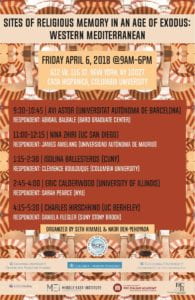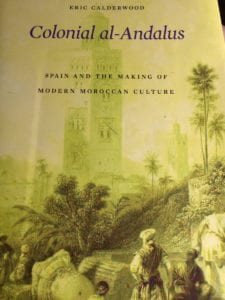These are remarks I prepared for a roundtable discussion on addressing modern topics in Medieval Studies classes held at the Inter-University Doctoral Consortium Medieval Studies Conference.
In the fall semester of 2016, I was teaching a CORE Cultures and Contexts course on medieval Spain. It happened that on the morning of November 9, I was slated to talk about the watershed year of 1391 which, following massacres and mass conversions, saw a sea change in the status of Jews in the Iberian Peninsula. The surprise result of the election and the next morning’s vandalism of a prayer space for Muslim students lent the campus a funerary air. In my experience here at NYU, a class on medieval Spain tends to attract two heritage populations: Muslim students and students from Spanish-speaking families. These students may be immigrants or the children of immigrants, they may be international students studying in New York from abroad, they may be third, fourth, or fifth generation Americans, they may be native English speakers or not, monolingual or linguistic polyglots. Despite the great diversity within these two student populations, one thing they have in common is that they belong to groups that had been the targets of hate speech, ridicule, threats, and fear-mongering throughout the election: the terrorists and the “bad hombres” of Donald Trump’s worldview. And the morning after we learned that this vision would be realized in the nation’s highest office, I had to ask my students, scared for their immediate safety and for their futures and shaken by the dystopian vision of what this place was quickly becoming, to care about the fourteenth century.
For those of you who are not immersed in the NYU undergraduate curriculum, our CORE program consists, in part, of three types of humanities courses: Cultures and Contexts, Texts and Ideas, and Expressive Culture. Students take a certain number of these and each section of each course is themed and taught by a member of faculty in a twice-weekly lecture format. These courses are designed for freshmen, although about half of our students delay completing this requirement until later in their career. For some, they are the only humanities classes they will take at NYU. For these reasons, one of my major goals in teaching in the CORE is that students use the literary materials from medieval Spain and the scholarship written on those materials to learn how to read critically and develop skills that will serve them as engaged and thoughtful citizens. As a goal for this particular type of class, this is even more important to me than anything they might learn about the Middle Ages per se. One of the episodes that comes up in the early weeks of this class is the ninth-century crisis of martyrdom provoked by Christians living in Arabic-speaking Córdoba; if my students can walk away from my class, log on to the New York Times and not assume, for example, that anyone who lives in an Arabic-speaking country is a Muslim, I consider that a success even if they forget the name of Paul Alvarus of Córdoba.
The days after the election presented an opportunity to challenge students to think critically about the kinds of rhetoric that had played a role in the campaign, within the framework of a medieval studies classroom. The most obvious form of writing to shape the discourse of the election was Donald Trump’s Twitter feed and the questions that it raised about audience, the mediation of text, and, in the form of fake news and Russian bots, forgery and reliability. Other parallel questions may be asked about tweets an medieval documentary sources with respect to genre, and with respect to the different kinds of impacts that different types of texts can have whether they are short or long, informal or formal, literary or documentary, or somewhere in between. With Trump’s penchant for deleting and editing tweets possibly in contravention of the Presidential Records Act and the Library of Congress’ coetaneous announcement that it was not going to be able to archive all of the tweets that had ever been tweeted in spite of its initial plans to do so, it also invites questions about archival practice and about the serendipity of documentary survival. This is how I came to introduce Twitter into my medieval studies classroom as both a topic and a tool.
In the weeks running up to the election, the historian David Nirenberg gave an interview in which he recounted some of the experience of writing his first book, Communities of Violence. He described the extent to which he had become distanced from the very violence that marked the conflictive coexistence of the Jewish and Christian populations of northern Spain and southern France that was the subject of his book; he had come to think of the details as exaggerated strategies of rhetoric rather than records of the reactions of medieval people to the violence they endured in their communities. He comments:
“All the documents talked about this massacre, but none of them gave any numbers. I came to the conclusion that this probably was not a big massacre. It happened in a tiny town in the middle of the mountains. They probably were talking about it as a massacre in order to justify the fines on the populace… On my last day of research in this archive, I came across one scrap of 14th century paper which said that dozens of people—300 or so, I think—were killed in the village. It even described how some were dragged from under their beds, and how their throats were slit. I suddenly realized that I had constructed this explanation which minimized this event, even though the full extent of the terror was only visible on that one little piece of 14th century paper.”
Nirenberg then connected this experience to reading study showing that Twitter was contributing to the uptick of hate-speech in the United States. Again quoting from that interview:
“I felt this way when I was forwarded this Twitter study, that I had pooh-poohed the effects of a technology I don’t really understand, when in fact it may very well conceal something much larger… We should probably worry more about something like these tweets because we’re in a space in which the use of anti-Judaism as a way of fantasizing the perfection of the world is already becoming very powerful.”
In other words, on Novermber 9, 2016, I tried to help my students connect to the Middle Ages when their minds were preoccupied with life-and-death matters of the modern by asking them to assess the capacity of micro-short-form writing, whether medieval or modern, not only to capture the Zeitgeist but also to provide details that we find in no other type of source.


 This is a lightly edited version of the comments that I made following Eric Calderwood’s talk at the Colubmia Workshop “Sites of Religious Memory in an Age of Exodus: The Western Mediterranean.” Part of the reason I’m posting my response is precisely because it is dependent upon reading his new book,
This is a lightly edited version of the comments that I made following Eric Calderwood’s talk at the Colubmia Workshop “Sites of Religious Memory in an Age of Exodus: The Western Mediterranean.” Part of the reason I’m posting my response is precisely because it is dependent upon reading his new book,